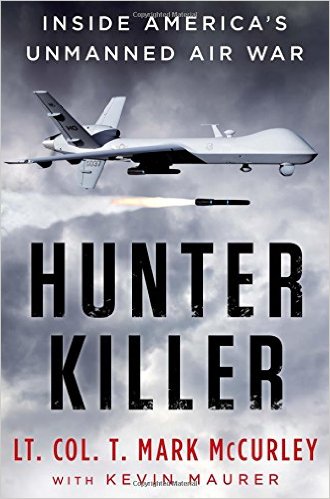Lieutenant Colonel McCurley has written an in-depth description of warfare as prosecuted by means of remotely piloted aircraft (RPA). This is the first book published that is devoted entirely to this subject. As such it covers the strategic and tactical decision making processes, the motivations of the operators, the early resistance and suspicions of commanders and ultimately the vital and timely contribution made by these vehicles by means of reconnaissance and strike operations.
The author stresses at the outset that “Drone” is not a suitable name for the aircraft although it is widely used by the media and general public. The aircraft are always controlled by pilots and there are always humans in the decision making chain of command. There is only one circumstance where the aircraft is under autonomous flight control and that is when there is a loss of signal and it is programmed to return to base. RPAs vary from model aircraft size used by the infantry to see “over the hill’ to the strategic reconnaissance Global Hawk which is as big as a small jet airliner and flies at 60,000 feet for many hours.
This book concentrates on the development and deployment of the Predator and Reaper RPAs, as depicted on the cover of the book, in Afghanistan, Yemen and Iraq.
McCurley was a qualified AWACS pilot and flying instructor and, like many others, he was outraged by 9/11 and wanted to get into the fight. He volunteered to fly RPAs and was very much the exception. For most such a posting was seen as a dead end and morale was not high. This changed rapidly after 2003 when McCurley entered the programme and within the next eight years covered in the book, the operations became thoroughly professional. The narrative is engrossing and the reader is given an explanation of how operations are flown, sometimes in desperate circumstances and in foul weather to save troops on the ground from being overrun or to kill a high-value enemy commander after weeks of patient observation. From being an oddity RPAs soon became ‘the tip of the spear”.
RPAs are based close to their areas of operation and are locally controlled for take-off and landing. After take-off they are handed off to the mission crews located in the US. The author experienced both of these postings and explains the procedures and hazards clearly.
The popular view of these crews is that they sit in front of screens far from danger and it is all akin to a video game. Nothing could be further from the truth and very high stress levels are endured when friendly force lives are at stake.
Forward air controllers in direct contact with the mission crews were instrumental in saving lives, a considerable technical and human achievement. Serious mistakes were made in the early days and innocent lives were lost. It is clear that every possible care is now taken to avoid this and the extreme precision of the weapons is a component of this.
This valuable book explains why RPAs have become so important and effective, suffering only a small loss rate per hours flown and avoiding risk to conventional aircraft crews. The Royal United Services Institute of Victoria Library wishes to thank the publisher for providing a copy for review.
Reviewed by Brian Surtees, January 2016

Allen and Unwin, Melbourne 2015 Paperback RRP: $32.99
Contact Royal United Services Institute about this article.






